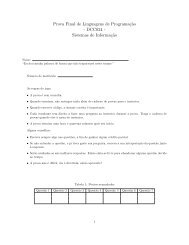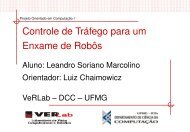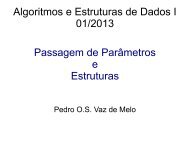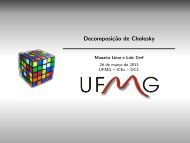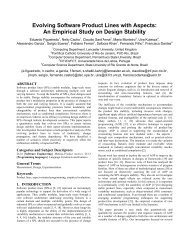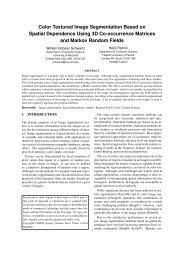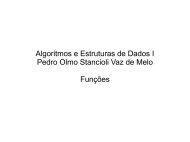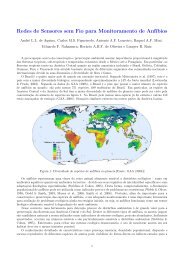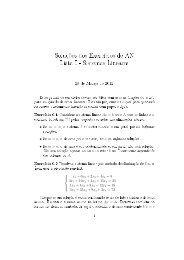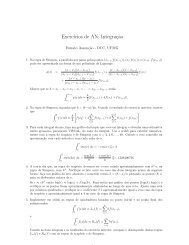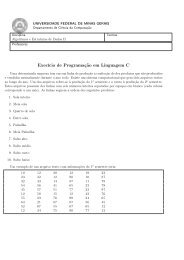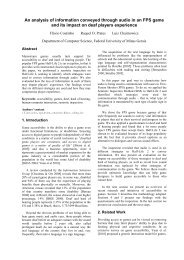A Geographical Analysis of Knowledge Production ... - ResearchGate
A Geographical Analysis of Knowledge Production ... - ResearchGate
A Geographical Analysis of Knowledge Production ... - ResearchGate
You also want an ePaper? Increase the reach of your titles
YUMPU automatically turns print PDFs into web optimized ePapers that Google loves.
over all pairs <strong>of</strong> nodes represents the average separation <strong>of</strong><br />
the coauthorship network and characterizes its interconnectedness.<br />
Another measure is the graph diameter, which is the<br />
longest distance between any two vertices <strong>of</strong> the graph. If<br />
we think <strong>of</strong> an edge as a means for conducting information<br />
between actors, the information can be spread more rapidly<br />
among actors in a graph with smaller diameter.<br />
A measure related to the graph diameter is the graph<br />
characteristic path size [15] (or average path size) calculated<br />
by computing the shortest path between every pair <strong>of</strong> vertices<br />
and calculating their average. A graph with a smaller<br />
characteristic path size can also conduct information faster<br />
than a graph with a long characteristic path size.<br />
Social networks typically have a small characteristic path<br />
size, which classify them as small-world networks. The small<br />
world phenomenon was identified for the first time in [11], in<br />
which the author obtained evidence that any two individuals<br />
in the United States are separated by a path formed by 6<br />
individuals, on average. This phenomenon was later called<br />
the six degrees <strong>of</strong> separation phenomenon. In this context, a<br />
small characteristic path size is orders <strong>of</strong> magnitude smaller<br />
than the number <strong>of</strong> graph vertices.<br />
In the context <strong>of</strong> a coauthorship social network, the clustering<br />
coefficient measures the degree <strong>of</strong> transitivity in the<br />
publishes with relationship that defines the graph. As an<br />
example, if the clustering coefficient is high, there is a high<br />
probability that a relationship between authors A and B,<br />
and another relationship between authors B and C will induce<br />
a relationship also between authors A and C. In other<br />
words, the clustering coefficient <strong>of</strong> a node in the coauthorship<br />
network indicates how much an author’s collaborators<br />
are willing to collaborate with each other. In this sense, the<br />
clustering coefficient indicates the existence <strong>of</strong> ordering in a<br />
local level [17]. More formally, the clustering coefficient <strong>of</strong> a<br />
node i can be defined as<br />
Ci =<br />
Number <strong>of</strong> triangles connected to vertex i<br />
Number <strong>of</strong> triples centered on vertex i .<br />
The global clustering coefficient is the average clustering<br />
coefficient <strong>of</strong> all nodes in the network, which can take values<br />
between 0 and 1 [18].<br />
The assortative mixing <strong>of</strong> a network refers to the preference<br />
<strong>of</strong> vertices with high degree to be connected to other<br />
vertices with high degree. The assortative mixing <strong>of</strong> a network<br />
can be quantified using a connected degree-degree correlation<br />
function [3], in which a positive number indicates<br />
an assortative network, a negative number indicates a disassortative<br />
network (i.e., vertices with high degree connect<br />
to other vertices with low degree), and 0 indicates a network<br />
without assortativity. Social networks are known to<br />
be assortatively mixed, while technological and biological<br />
networks tend to be disassortative [14].<br />
4.2 Statistics <strong>of</strong> the Three Networks<br />
The three generated networks represent Brazilian, North-<br />
American and European programs, from now on referred to<br />
as Br, Ca-US and Fr-Sw-UK networks, respectively. The basic<br />
statistics <strong>of</strong> these networks are summarized in Table 3.<br />
The largest network is the Ca-US network with 1,008 authors<br />
and 40,039 papers over a 12-year period. The number<br />
<strong>of</strong> papers per author is much larger for researchers in US and<br />
Canada, dwarfing the two other networks. The number <strong>of</strong><br />
papers per author was calculated by averaging the number<br />
<strong>of</strong> papers for each author in the dataset. Notice that this<br />
is different from simply calculating the division between the<br />
number <strong>of</strong> papers and the number <strong>of</strong> authors, since each paper<br />
can have more than one author. The Ca-US network<br />
has the highest number <strong>of</strong> papers per author (45.89), much<br />
higher than the the Fr-Sw-UK (19.85) and the Br (16.06)<br />
measurements.<br />
The number <strong>of</strong> authors per paper exhibit a similar pattern<br />
for the three networks, ranging from 2.87 to 3.21. It is worthnoting<br />
that these numbers vary significantly across different<br />
subject areas. In [16], the number <strong>of</strong> author per papers in<br />
Biology, Physics and Mathemetics vary from 5.1 to 6.9, reflecting<br />
differences in the way research is done in those fields.<br />
The number <strong>of</strong> callaborators an author has in the Br and<br />
Fr-Sw-Ok networks are very close (18.64 and 17.78, respectively),<br />
whereas in the Ca-Us network this number is more<br />
than two times higher (42.11). This is presumably a result <strong>of</strong><br />
the way computer scientists work in US and Canada, where<br />
there exists many links among universities and companies.<br />
Table 3: Statistics for the Br, Ca-US and Fr-Sw-UK<br />
Networks<br />
Br Ca-US Fr-Sw-UK<br />
Number <strong>of</strong> Authors 357 1,008 488<br />
Number <strong>of</strong> Papers 4,405 40,039 8,764<br />
Papers per Author 16.06 45.89 19.85<br />
Authors per Paper 3.21 2.87 2.77<br />
Average<br />
Collaborators<br />
18.64 42.11 17.78<br />
Giant Component<br />
Average Giant<br />
78.15% 78.27% 26.17%<br />
Component for<br />
Isolated Programs<br />
67,41% 56,46% 30,01%<br />
Average Path<br />
Length<br />
6.47 4.42 6.18<br />
Diameter 16 12 15<br />
Clustering<br />
Coefficient<br />
0.30 0.20 0.38<br />
αDegreeDistribution 1.51 1.77 1.89<br />
Assortativity 0.25 0.35 0.38<br />
Now we present a comparative analysis <strong>of</strong> structural features<br />
<strong>of</strong> the three networks, by comparing measurements<br />
that characterize the network structure. The number <strong>of</strong><br />
nodes <strong>of</strong> the the giant component plays an important role<br />
in coauthorship networks, since it represents the portion <strong>of</strong><br />
the authors that are connected via collaboration. Any author<br />
in the giant component can be reached from any other<br />
by traversing a path <strong>of</strong> intermediate coauthors. The figure<br />
<strong>of</strong> 78% for the size <strong>of</strong> giant component in Ca-US and<br />
Br indicates that the majority <strong>of</strong> Computer Science authors<br />
in these regions are connected, avoiding the proliferation <strong>of</strong><br />
small isolated communities.<br />
In contrast, the giant component size in Fr-Sw-UK is only<br />
26%. One possible explanation is the existence <strong>of</strong> graduate<br />
programs from different countries (with different languages)



